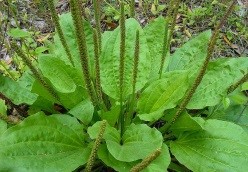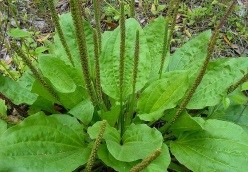Area
Geographical distribution. It is widespread in all districts of the country along roadsides, fields, arable lands, meadows, forest edges, riverbanks and abandoned wetlands.
Botanical description of the plant
Large zupturum - Plantago major L., Zupturumdashlar - belongs to the family Plantaginaceae. Zupturum is a perennial, short and thick-rooted herbaceous plant. On the upper side of the rhizome (above ground) grow long, winged banded root balls, and on the lower side (underground) grow many small roots. The anterior roots are broadly elliptical or broadly ovate, flat-edged and large. Flower axis single or multiple, hairless, 10-45 cm tall. The flowers are gathered in a simple spike. The flower is small, unsightly. The inflorescence is divided into four parts, the inflorescence is light brown, four-part, paternal 4, 1 maternal node »two-room, located at the top. The fruit is an ovoid, multi-seeded pod. It blooms in May-June.

Medicinal properties
Infusion, tincture, canned juice of freshly harvested, not dried leaves, plantoglycid preparation, leaf briquettes. The herbal drug is used in coughs, asthma and other gastrointestinal diseases
Growing technology
In all soil and climatic conditions of the Republic of Uzbekistan it is possible to grow a large zupturum plant. In its good growth and development, the mechanical composition of the soil should be moderate, soils close to streams and cleared of weeds should be separated. Areas planted with large zupturum are plowed in autumn, before plowing, to a depth of 22-25 cm, giving 20-25 tons of manure per hectare, 50 kg of pure superphosphate fertilizer. As the plant is perennial, it can be sown in autumn and early spring. If a large zupturum plant is planted in the fall, the soil is plowed 25-30 days before planting. With the emergence of weeds, cultivation and harrowing are carried out. In autumn, the seeds are sown in wide rows in a dry state without sorting. Depth of seed should not exceed 0.5-1.5 cm. Seed depth of seeds sown in autumn and spring should not exceed 0.5-1.5 cm, sowing rate should not be less than 5-6 kg per hectare and germination rate should not be less than 70-80%. . The seeds are sown in vegetable seeders. Seedling thickness should be 8–10 balls per 1 m. If the seeds are sown in early spring, they are stratified before sowing in order to accelerate their germination (stored for 1-2 days at a temperature of 18-20 ° C in moisture), if sown in the fall, they are not stratified. In the climatic conditions of Uzbekistan, planting large zupturum in autumn requires less labor, reliable and complete seedlings. From seeds sown in autumn and those sown in spring, the grass sprouts in 10-12 days. Use of plant-planted fields 3–4 years. Caring for a large zupturum plant After the leaves have formed on the plant, the soil is loosened by carefully cultivating them so that they do not attach to the soil. It is weeded and soaked. During the growing season, taking into account the development of the plant, it is fed twice with an average of 90 kg of nitrogen, 40 kg of phosphorus and 40 kg of potassium fertilizer per hectare. In the second and subsequent years, both during the mowing period and after the leaf is harvested, it is fed twice with mineral fertilizers using cultivators. Feeding is carried out before watering. During the season, it is watered 10 to 12 times, taking into account the temperature and humidity, and cultivated 4 to 5 times to loosen the soil and remove weeds. 1.5-2 tons of dry leaves per hectare can be harvested if high-quality agro-technical measures are taken in large emerald growing areas.





